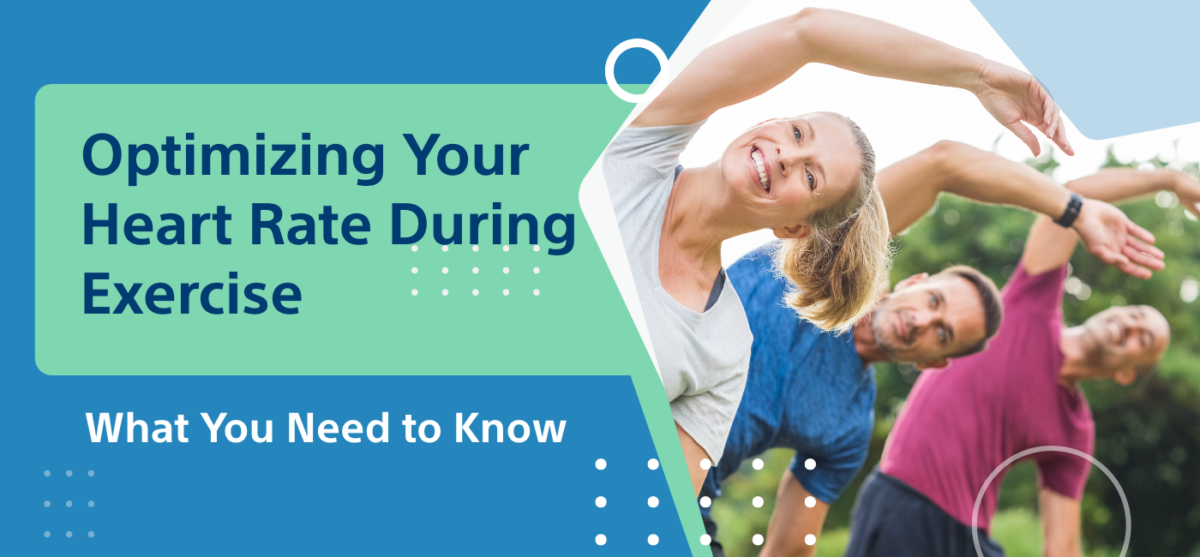Optimizing Your Heart Rate During Exercise: What You Need to Know

Knowing how your body responds while exercising can greatly contribute to the success of the same, and something that tells you a lot about your fitness condition would be the heart rate. In a nutshell, monitoring and perfecting your heart rate during workouts will allow you to tell if you are working at the proper intensity for your goals – be it to achieve weight loss, boost cardiovascular health, or improve endurance.
In this guide, we’ll explain all different facets of heart rate control and give you some key takeaways for a healthy heart.
Understanding Heart Rate Zones
It is before getting into the best ways to optimize your heart rate during exercise that it would be important to understand the concept of heart rate zones. These zones symbolize the different classes of exercise intensity and each has a specific purpose to serve in your fitness routine.
• Resting Zone: This is the rate at which your heart beats when you are thoroughly rested. Most adults rest between 60 and 100 beats per minute. A lower resting heart rate usually indicates being in good cardiovascular health.
• Fat-Burning Zone: This is typically the zone that lies between 50% and 70% MHR. It’s often when you burn fat during low-intensity workouts that do not require you to run or to be intensely active. This is likely to include brisk walking or light jogging.
• Cardio Zone: This ranges in the zone between 70% and 85% MHR and is applicable for building cardiocirculatory endurance via exercising activities like running, swimming, or cycling.
• Anaerobic Zone: This falls within the 85% to 90% MHR and is applied on specific occasions in HIIT to build strength and speed.
• Peak Zone: It is the extreme intensity level, which falls above the 90% MHR, to be applied for limited periods during maximal exertion.
How to Calculate Your Maximum Heart Rate (MHR)?
The formula most commonly used to estimate MHR is 220 – your age. So if you are 30 years, your estimated MHR is 190 bpm (220-30 = 190). All that is well and good, but since every person’s heart rate is a bit different, it’s a good idea to use heart rate monitors or fitness devices to track the number for each workout.
Benefits of Monitoring Heart Rate During Exercise
There are several key benefits to keeping an eye on your heart rate during exercise. By staying aware of how your heart is functioning, you can tailor your workout to meet your fitness goals more effectively. Let’s break down some of the benefits:
- Optimized Workout Intensity: Monitoring your heart rate helps you exercise within your optimal heart rate zone, whether you’re aiming to burn fat, improve endurance, or build strength. For example, if you’re in the fat-burning zone, you’ll know that your body is using stored fat for energy rather than burning muscle.
- Tracking Fitness Progress: As you improve your cardiovascular health, you may notice a lower resting heart rate and faster recovery after intense exercise. These are signs of a stronger heart, and regularly tracking your heart rate allows you to measure this progress.
- Preventing Overtraining: Keeping your heart rate within a safe range reduces the risk of pushing yourself too hard, which could lead to overtraining, fatigue, or even injury. Regularly overexerting yourself can strain the heart unnecessarily, which goes against tips for a healthy heart.
Monitoring your heart rate during exercise serves as a useful tool for maintaining balance in your fitness routine and ensuring you aren’t overworking your body.
How to Measure Your Heart Rate?
To effectively monitor your heart rate during exercise, there are various methods and devices available:
- Fitness Trackers and Smartwatches. Using wearable technology is possible while wearing Fitbit, Garmin, or Apple Watch to keep a record of your heart rate when you work out. It shows you real-time data so that you stay in the target heart rate zone.
- Chest Straps-Chest strap monitors, by Polar and others, will give the most accurate heart rate information. These will fit across the chest near the heart; thus, they are best suited for high-intensity performers or anyone interested in accurate data.
- Recording : If you do not have the technology, you can record the heart rate manually by placing two fingers on the wrist or neck and counting the beats per 15 seconds, then multiplying by four to get the bpm.
The monitoring of heart rate during exercise is consistent. This can give you important feedback in order to change your working practice.
Optimal Heart Rate for Different Exercises
It’s how this rate changes from one type of exercise to another that helps you tune into what you can do better. And get the most out of your efforts at exercising. The best heart rate or training intensity differs for each of these: aerobic exercise, strength training, high-intensity intervals.
• Cardio: Aerobic Exercise. It will help to enhance the cardiovascular endurance in order to keep someone on their toes, fully moving oxygen through the heart, lungs, and muscles for running, swimming, or cycling. The zone for cardio is 70% to 85% of MHR.
• Strength Exercise: The heart rate for strength exercises won’t be as high as it is for cardio exercise; however, monitoring it allows you to ensure you’re at an intensity level that’s contributing to your muscle growth and fat loss. For muscle-building purposes, most strength training is optimal at 60%-70% MHR.
• HIIT: HIIT is characterized by elevating your heart rate into the anaerobic or peak zones for short intervals and, thus, allows the burning of calories while improving cardiovascular fitness and muscle endurance.
The hallmark here is to switch your heart rate goals depending on your style of workout so you do not overtrain.
The Role of Resting Heart Rate in Fitness
Resting heart rate is a measure of your general heart fitness and health. Conversely, generally speaking, low RHR means that the cardiovascular system is well-conditioned. Examples of elite athletes have RHR ranging from 40 to 60 beats per minute.
Cardio exercises, such as walking, jogging or swimming, will raise your resting heart rate in time. This is because it leads to an elevated efficiency of the heart in pumping blood with each beat, therefore requiring less beats per minute to provide the body with oxygen.
Use the resting heart rate as a benchmark for measurement of change as you try to optimize your heart rate exercise.
Heart Rate and Age: Are Your Goals a Boondoggle?
Age sets your maximum heart rate during exercise. As you get older, your MHR decreases in harmony, and your target heart rate zones will shift.
- Age 30: This is an approximation of your maximum heart rate, which would be 190 bpm (220 – 30 = 190). Your cardio zone would range from 133 to 161 bpm (70%-85% of MHR).
- At age 50, your estimated MHR lowers to 170 bpm, and your cardio zone decreases to 119-145 bpm. At this stage, ensure you exercise at a safe yet effective intensity that will promote cardiovascular well-being without straining the heart. It is superb to use heart rate charts or heart rate monitors when exercising to determine if it is still at the appropriate age for your workout.
Signs of an Overworked Heart
Heavy physical workout can grant you better fitness; however, overdoing it may cause more harm than good. Here are some signs that your heart has overexerted while working out:
- Dizziness or dizziness: This is a sign of having trouble keeping up with the demands of your workout or exercise.
- Breathlessness: Though some degree of breathlessness is expected with very strenuous activities, a more serious inability to breathe may indicate that your heart rate is too high.
- Extreme exhaustion: Over-exertion causes extreme exhaustion that persists even after you have stopped exercising. This proceeds to negatively affect recovery as well as general health
Avoid these issues by keeping to recommended heart rate zones and taking breaks as often as you need to. If you have heart-related symptoms while exercising, consult with a healthcare provider about it.
Building a Heart-Healthy Workout Routine
As you go about creating an exercise routine, keep in mind the ultimate goal is to maintain a balance between the intensity of your workouts and recovery. Add the following tips into your routine as you go toward long-term heart health:
• Warm-Up and Cool Down: A good warm-up gradually raises the heart rate and prepares the body for intense activity. Cool down helps bring the heart rate back to normal, thus avoiding dizziness or strain.
• Cardio with Strength Training Benefits the Heart Both cardio exercises and strength training work in different ways to help hearts. Cardio represents a cardiac strengthening exercise; it tries to strengthen the heart and lungs. On the other hand, strength training raises muscle mass and endurance, which supports general cardiovascular function.
• Rest and Recovery: Coverage of the gap between the sessions of exercise through time for recovery lets your heart and muscles heal themselves and, in that respect, reduces chances of overtraining. So, it will maintain cardiovascular health in the long run by making sure to listen to your body, letting go of excessive intensity at times, and also at other times, giving a play to intense levels of recovery.
Role of Diet and Hydration in Heart Rate Control
Proper nutrition and hydration are two of the most important components that help manage the rate of beating in the heart during the course of exercising.
- Intake of heart-healthy foods: Whole grains, lean proteins, fruits, and vegetables promotes balanced blood pressure and cholesterol levels and maintains a healthy rate of the heart while in motion.
- Hydration: Dehydration can sometimes cause one’s heart to have to work much more than it ought to, thus increased heart rate. Drink water before exercise, maintain water intake throughout the exercise, and hydrate after exercise to maintain a healthy heart rate while exercising.
- Optimal heart rate: While exercising is more of nutrition and hydration than the exercise itself, it has a lot to do with the nutrition and hydration you are taking before, during, and after workout to meet cardiovascular performance demands.
Consulting a Doctor for Personalized Heart Rate Goals
For beginners or those with critical heart conditions, getting a doctor or a fitness professional can really help you out. Personal advice by your healthcare provider lets you know what your heart rate goals should be in respect of your health status and ability.
Understand how heart rate is used in exercise and, by learning these tips for a healthy heart, you will be able to make your way safely to the fulfillment of long-term goals for the improvement of cardiovascular health. Measuring your heart rate during exercise will keep you on track, in relation to your health goals as you end up working smarter than harder.









